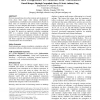Free Online Productivity Tools
i2Speak
i2Symbol
i2OCR
iTex2Img
iWeb2Print
iWeb2Shot
i2Type
iPdf2Split
iPdf2Merge
i2Bopomofo
i2Arabic
i2Style
i2Image
i2PDF
iLatex2Rtf
Sci2ools
CHI
2005
ACM
2005
ACM
Fluid integration of rotation and translation
Previous research has shown that rotation and orientation of items plays three major roles during collaboration: comprehension, coordination and communication. Based on these roles of orientation and advice from kinesiology research, we have designed the Rotate'N Translate (RNT) interaction mechanism, which provides integrated control of rotation and translation using only a single touch-point for input. We present an empirical evaluation comparing RNT to a common rotation mechanism that separates control of rotation and translation. Results of this study indicate RNT is more efficient than the separate mechanism and better supports the comprehension, coordination and communication roles of orientation. Author Keywords Fluid interactions, rotation, translation, orientation, roles of orientation, tabletop collaboration, communicative gestures ACM Classification Keywords H.5.3 [User Interfaces]: Interaction styles; [Information Interfaces and Presentation]: Group and Organization I...
CHI 2005 | Common Rotation Mechanism | Evaluation Comparing Rnt | Human Computer Interaction | Study Indicate Rnt |
| Added | 30 Nov 2009 |
| Updated | 30 Nov 2009 |
| Type | Conference |
| Year | 2005 |
| Where | CHI |
| Authors | Russell Kruger, M. Sheelagh T. Carpendale, Stacey D. Scott, Anthony Tang |
Comments (0)

